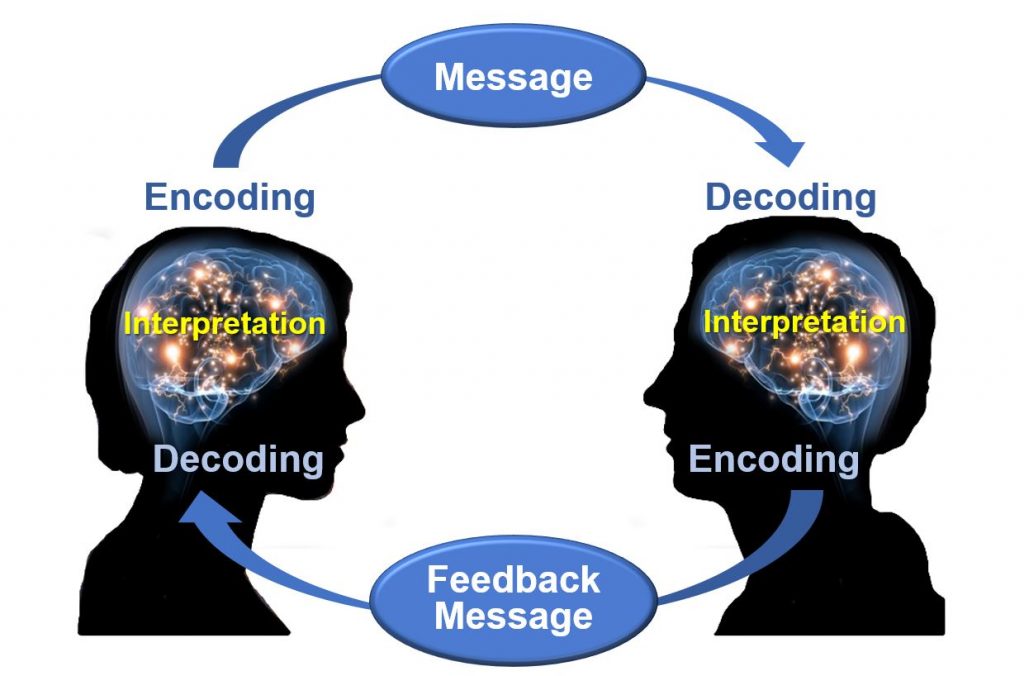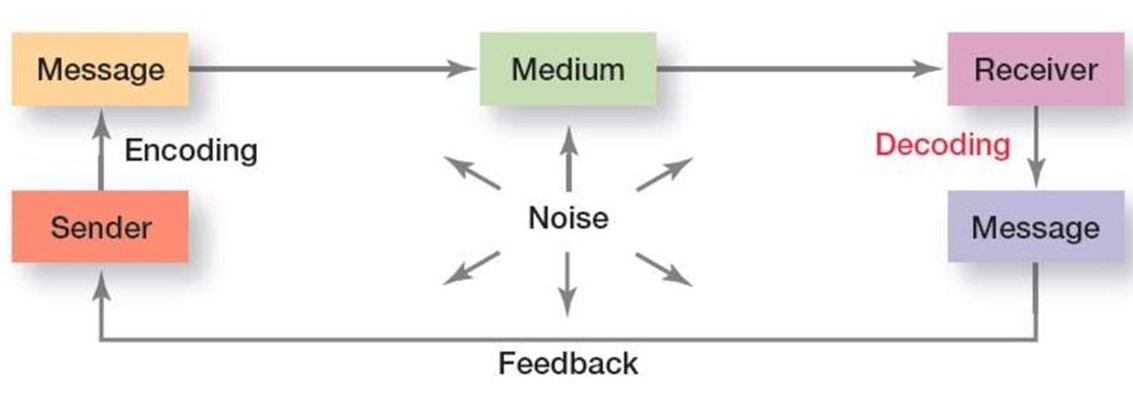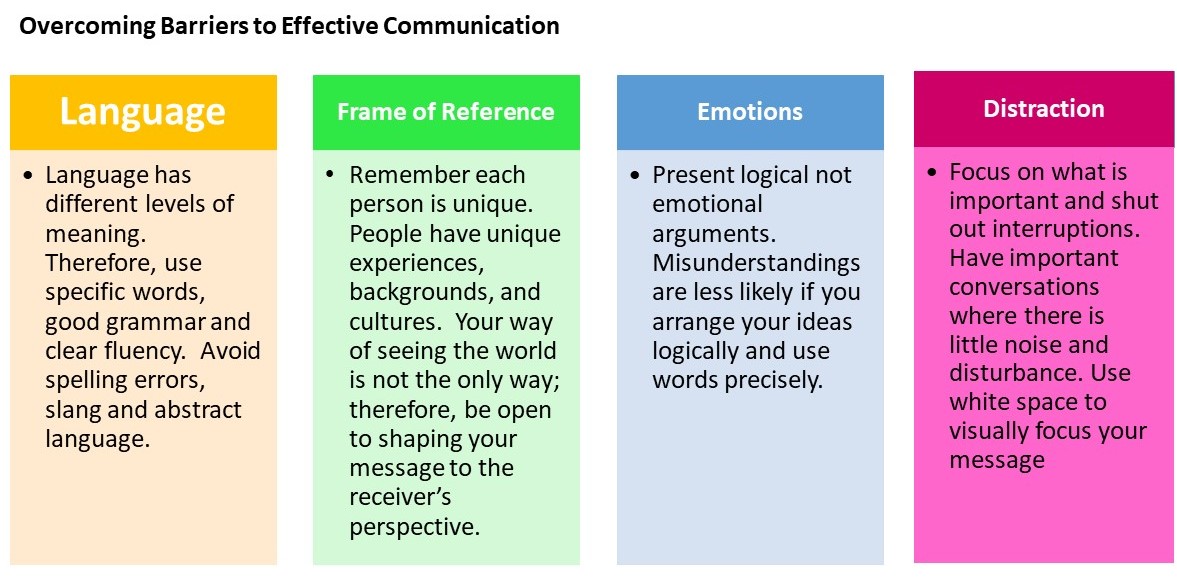63
Chapter Essential Questions
What written, verbal and interpersonal skills are required for a manager working in First Nation communities?
How can a strategic approach benefit communication?
Lesson 1: The Communication Process
Outcomes
By the end of this lesson, you should be able to:
- Define the communication process and its breakdown, and discuss common communication barriers and strategies for avoiding them.
- Define the characteristics of great communicators and how they can benefit the workplace.
- Identify your own communication style.
- Describe the three types of communication -verbal, nonverbal, and written – and explain how to use them effectively.
- Discuss different mediums and their impact on communication success, and identify strengths and weaknesses of common medium.
What is Communication?
Everything in life has a process, including communication. We also use communication in our daily lives in many forms. When you call someone, send a text or have a face-to-face conversation, you are engaging in communication.
The process of communication is complicated and refers to “the transmission or passage of information or message from the sender through a selected channel to the receiver overcoming barriers that affect its pace. The process of communication is a cyclic one as it begins with the sender and ends with the sender in the form of feedback.” [1]
Communication is essential to being a productive and effective manager. The communication process includes a sender (the person speaking, sending the text or emailing), the receiver (the person listening, reading the text or email) and the message (the content or words of the message).
The Communication Process

Figure 2.1: The Osgood-Schramm model of communication. Sources: Kisspng, 2018; Web Editor 4, 2017
Did you know?
Communication in First Nations culture are approached differently than Westernized culture. Below you will find the most common forms of First Nation communications.
Barriers to Communication
Even though communication seems simple, it is often not. Barriers and distractions can cause common communication to become an issue. How many times have you thought you have clearly communicated an idea only to find out later it was misunderstood? Anything that interferes with clear communication is called Noise. Understanding clear communication can be improved by understanding noise or barriers.

Figure 3.1: Every step in the communication process can be disrupted by Noise. (Source: https://en.ppt-online.org/344580)
Common forms of noise or barriers can include:
Overcoming Communication Barriers
Overcoming communication barriers can make a difficult conversation easier. The figure below provides strategies to help you overcome four different noise issues.

Figure 3.3: Strategies to overcome communication barriers. (Business Communications, 2018)
| 1. Director | 2. Expresser |
| Goal oriented | People oriented |
| Tells it like it is | Animated, easily excitable |
| Makes decisions quickly | Makes impressive gestures |
| Always on the go | Entertaining |
| Speaks crisply | Thinks out loud |
| May be insensitive, intimidating | Speaks rapidly |
| May be imprecise | |
| 3. Thinker | 4. Harmonizer |
| Task oriented | Relationship oriented |
| Make lists | Sensitive to others |
| Does things “by the book” | Dedicated, loyal |
| Speaks deliberately | Speaks softly |
| Believes there’s a right way and wrong way | Avoids conflict |
| May procrastinate | May over-commit |
Author Unknown. (2023). Communications styles. [Graphic]. Straight talk: Communication Style Training.
Communication can be categorized into three types: verbal, nonverbal and written. Verbal communications in business take place over the phone or in person. The medium of the message is oral. Verbal communication can occur formally (a meeting or scheduled time) or informally (meeting someone at the store or on the road).
Indigenous cultures around the world have been known for using storytelling to share and inform others of current events, legends and lores and other important information. Storytelling has been shown to be an effective form of verbal communication and can help individuals to construct their own meaning within an organization. Stories can help clarify key values and help demonstrate how things are done within an organization, and story frequency, strength, and tone are related to higher organizational commitment (McCarthy, 2008).
Written communication is another important medium and can include email, text, or on a computer screen. Unlike verbal communication, written communication can be assessed at any time and when the manager feels it is convenient. Thomas Jefferson summed up the rules of writing well with this idea, “Don’t use two words when one will do.” This means that whenever and wherever possible, keep the writing simple and to the point.
Finally, the third type of communication is non-verbal or body language. Effective communicators know that what they are not saying means just as much as what they are saying. Research shows that when individuals are lying, they are more likely to blink more frequently, shift their weight, and shrug (Siegman, 1985). Tone, eye contact and your facial expressions all play an important role in how others receive and interpret the message you are sending them. Your posture, the space between the communicators and touch are other key factors in non-verbal communication.
Different Mediums of Communication
According to Richard Nordquist (2020), “a medium is a channel or system of communication—the means by which information (the message) is transmitted between a speaker or writer (the sender) and an audience (the receiver)”.
Face-to-face communication – have you ever had to meet with a client to discuss a change in housing? Or bumped into a colleague at the photocopier and began talking about an important issue? Then you have experienced the most common type of workplace communication which is face-to-face. It includes two or more people and can happen both in and outside the office.
Virtual remote communication – with Covid many of us were introduced to remove communication. When you have a zoom meeting, send an email or text you are choosing virtual remote communication. This type of communication includes sending a message to someone in another location with the use of technology. It can also include written, verbal and visual aspects.
Written communication- have you ever left a hand written note for a co-worker? Or wrote down notes from a meeting? Then you have participated in written communication. This form of communication includes physically written notes, letters and memos and can be both formal and informal depending on the purpose.
Social media communication – It feels like social media is everywhere – on our computers and on our phones. Social media is being used more and more to promote messages and reach broader audiences. Many organizations have a Facebook page, Twitter account, or even use TikTok to spread messages on important issues or ideas.
Questions to ask yourself when choosing the best medium:
Is this an urgent or non-urgent message?
Should this communication be formal or non-formal?
What is the purpose of the message? Am I instructing someone to do something or simply sharing new information?
What is my relationship with the receiver of this message?
Is this message accessible to the person who will be receiving it?
Journal Prompt
Using the forum labelled Course 5: Lesson 1 make a journal entry responding to the prompt belows. Ensure that you title the entry “Lesson 1”. After writing a journal entry, go and make a comment on two other posts from your classmates. It can be about anything you noticed, liked, agreed with etc. The idea is to continue the dialogue about the topic.
- When you see a memo or e-mail full of typos, poor grammar, or incomplete sentences, how do you react? Does it affect your view of the person who sent it? Why or why not?
- How aware of your own body language are you? Has your body language ever gotten you into trouble when you were communicating with someone?
- How does body language differ in cultures? What is one example that you have seen of cultures using body language in different ways?
Journal Entry Evaluation Rubric
|
Criteria |
Exemplary (4) |
Accomplished (3) |
Developing (2) |
Beginning (1) |
|
Purpose |
Strong voice and tone that clearly addresses the purpose for writing. |
Appropriate voice and tone. The purpose is largely clear. |
Attempts to use personal voice and tone. Somewhat addresses the intended purpose. |
Demonstrates limited awareness of use of voice and tone. Limited evidence of intended purpose. |
|
Understanding |
Many interesting, specific facts and ideas are included. |
Many facts and ideas are included. |
Some facts and ideas are included. |
Few facts and ideas are included. |
|
Conventions |
All grammar and spelling is correct. |
Only one or two grammar and spelling errors. |
A few grammar and spelling errors. |
Many grammar and spelling errors. |
|
Reply |
Made two significant contributions to the online forum. Highly supportive of others. |
Made one contribution to the online forum. Supported group members. |
Attempted to contribute to online forum but was vague and unclear in the writing. |
Minimally involved. Offered limited support to online group members. |
References
McCarthy, J. F. (2008). Short stories at work: Storytelling as an indicator of organizational commitment. Group & Organization Management, 33, 163–193.
Nordquist, R. (2020, February 5). What is the medium in the communication process? ThoughtCo. Retrieved April 23, 2023, from https://www.thoughtco.com/medium-communication-term-1691374
Siegman, A. W. (1985). Multichannel integrations of nonverbal behavior. Hillsdale, NJ: Lawrence Erlbaum.
- Effective Communication - Process: Learning Effective Communication: Absolut Beginners, 2023. Retrieved on April 21, 2023 from https://www.tutorialspoint.com/effective_communication/effective_communication_process.htm# ↵
- Goh & Kulathuramaiyer (2020) Developing an Indigenous Cultural Values Based Emoji Messaging System: A Socio-Technical Systems Innovation Approach. DOI 10.1145/3394332.3402826 ↵
